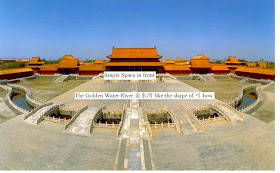 Kun Gua
Kun Gua
The 交泰卦 Jiao Tai Gua in 64 gua I-Ching is Kun Gua on top of the Qian Gua
 The three main halls are all located on the highest land of the Forbidden City which form the Chinese character, ' Earth ' , symbolizes the Central soil.
The three main halls are all located on the highest land of the Forbidden City which form the Chinese character, ' Earth ' , symbolizes the Central soil.  Temple of Heaven 天壇
Temple of Heaven 天壇
Ample Space in front of the palace
 午门 Main Entrance at the South
午门 Main Entrance at the South 东华门 donghuamen Entrance at the East
东华门 donghuamen Entrance at the East
东华门 donghuamen Entrance at the East

The Ming emperors stayed in the 乾清宫 Qian Ching Gong
If you look down from the sky, the three main halls are all located on the highest land of the Forbidden City which form the Chinese character, ' Earth ' , symbolizes the Central soil. The Forbidden City is facing the south which is the direction of fire. As fire grows earth because whatever you burn, the residue will become earth eventually. Yellow is the colour of the land which believed to belong to the emperor himself. Therefore the tiles of the roof of all the buildings in the palace are in yellow colour. The truth is the Red symbolizes fire element, all the walls in the Forbidden City are in are in red colour.
Confucius: facing the South while listening to the world 南面而听天下. Because the 'before heaven bagua’ indicates that the South is the direction of heaven. Therefore, the South of the Forbidden City are the Tiananmen Square天安门 and the Temple of Heaven天壇 which mean the heaven 'tian' 天. It is in line with what I said in my book How To Enhance Your Wealth With Feng Shui? page 40 i.e. If you have ample empty spaces in front of your house, the power in gaining wealth is strong. Empty land in front of your building is good 明堂 ming tang ‘bright hall’. Even better, if have a clear and clean water view. If so, enlarge your main door to welcome good qi of wealth.
All the doors at the entrances of the Forbidden City are doors with 81 nails as 9x9 81, because the number 9 is the greatest number, but only one door is with 9x8 72 nails i.e. donghuamen, 东华门 the door at the East because East is the direction of the wood or plant. Plant breaks the earth as the roots of the plants will break the soil thus the door at the East has to be downgraded. The status of the donghuamen is relatively low. In fact, before the construction of the Forbidden City, the then emperor 明永乐皇帝 did not want to have the donghuamen.
The Ming emperors stayed in the 乾清宫 Qian Ching Gong as the Qian 乾 Gua is the gua of the King, father, yang and the master. Whereas, the queen resided in the 坤宁宫 Kun Ning Gong as Kun 坤 is the Gua for the Queen, mother, yin or the lady master. The building in between the two main buildings is the Jiao Tai Palace 交泰殿 which mean the intersection between the yin female and the yang male in I Ching which symbolizes prosperity in the future generations of the emperor. The 交泰卦 Jiao Tai Gua in 64 gua I-Ching is Kun Gua on top of the Qian Gua thus, you could notice the only picture with phoenix on top of the dragon is in the Jiao Tai Palace 交泰殿. The dragon represents the King and Phoenix 鳳 is the Queen. Therefore dragon should be on the top of the phoenix to show the superb status of the King. But, you could see the only picture in the Forbidden City with Dragon 龙 below the Phoenix 鳳 is in the Jiao Tai Palace 交泰殿.
There are 6 palaces 东西六宫 each beside the Kun Ning Gong 坤宁宫 which means 六六大顺 smoothness without any obstacle. The palaces are the palaces for the high ranking mistresses of the emperor. Their arrangements are six on each side of the Kun Ning Gong 坤宁宫 is also according to the I-Ching Kun Gua, 3 broken line which forms the 6 shorter lines.
According to the orientation of the ‘later heaven bagua’, the East sector is the gua of the eldest son 震卦, so the Prince was to live at the East of the Forbidden City.
The ancient coin is circular with a square hole in the middle represents the heaven or the sky is surrounding the Earth. This is because according to the bagua, shape for the Qian Gua which is North West sector of the bagua is circular and the shape for the gold is circular but the shape of the Kun Gua is square. Thus, the shape of the Temple of Heaven天壇 is circular in shape.
The ancient coin is circular with a square hole in the middle represents the heaven or the sky is surrounding the Earth. This is because according to the bagua, shape for the Qian Gua which is North West sector of the bagua is circular and the shape for the gold is circular but the shape of the Kun Gua is square. Thus, the shape of the Temple of Heaven天壇 is circular in shape.
三大殿都建在’土’字型的台基上,象徵着中央土而南方属火,整个紫禁城坐北朝南. 火生土, 皇帝为天子, 地上之皇, 因此皇帝黃袍加身, 黃色为土地的颜色. 因此宫殿内大多数之瓦顶皆用黄色,其道理在此. 五行之赤色象征 火,所以紫禁城所有的墙、门、窗、柱、框一律用红色。火生土. 孔子曰 : 南面而听天下. 前天八卦的南方属天, 乾为天. 因此南方有天安门和天壇.
城墙四面都有门,南有午门,北有神武门,东有东华门,西有西华门. 所有的门都是9x9 81颗门钉, 因为9是最大数目, 但唯独东华门是9x8 72颗门钉因为东方属木, 不可让木来克土呀! 因此东华门的地位较小.
内廷主要三宫有乾清宫、交泰殿和坤宁宫. 明朝皇帝都住在乾清宫因为乾卦为最重要的男主人卦位, 乾清宫象徵天, 而坤宁宫象徵地, 乾清宫比太和殿稍微小. 乾为天, 天为阳, 坤为地,地为阴, 坤宁宫为明朝皇后的住所. 交泰殿为阴阳二气交会处. 易经里的泰卦是乾下坤上, 所以在交泰殿可以看到紫禁城内唯一的鳳上龙下的图象, 代表着阴阳二气交会而子孫滿堂.
内廷主要三宫乾清宫、交泰殿和坤宁宫的两旁为东西六宫, 有六六大顺之义, 也是易经里的坤卦(三畫卦). 后天八卦的震卦为长子的方位, 所以太子是住在东方的震卦.
紫禁城的南方为天或易经里的乾卦, 因此有天安门和天壇, 天壇是圆形的因为圆形代表天. 紫禁城的北方为地或易经里的坤卦, 因此有地壇, 地壇是方形的因为方形代表地. 古代铜钱是圆形而中间有方形的洞代表着天包圍着地呀! 紫禁城的东方为日或易经里的离卦, 因此有日壇. 东方为太陽升出的地方. 紫禁城的西方为月或易经里的坎卦, 因此有月壇. 这都是跟据易经里的前天八卦所造呀!



[color=#cc3300]Nice post! thank you for sharing this information. penangfengshui.blogspot.com really got under my
ReplyDelete[/color] [url=http://nuscin-online.info]skin,[/url] [color=#cc3300]bookmarked... Keep up the great site...[/color]
Genial brief and this post helped me alot in my college assignement. Thank you on your information.
ReplyDelete